Pastrami From a Corned Beef Recipe
Moist, Tender, And Full Of Flavor, This Is The Homemade Smoked Pastrami Recipe That All The Other Sites Have Copied
So what is pastrami? Simply put, it's Jewish barbecue, a.k.a. corned beef with chutzpah! You want the recipe, it's on this page, but first I have to tell you something.
The most revered pastrami is found at Katz's Delicatessen in New York City. Katz's is a timeless throwback and is the site of Harry met Sally's fake orgasm. When you go, make sure to leave your diet behind and remember to say I'll have what she's having! (click here to share this on Twitter).
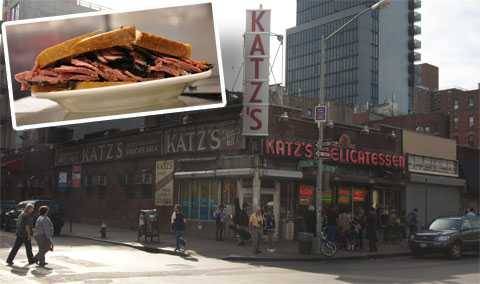
When I first set out to create my own homemade pastrami recipe years ago, the one that has been copied all over the internet, I went directly to the source. I hung out at Katz's in lower Manhattan. Then I pumped Katz's Chef Kenny Kohn for tips and technique for cooking and smoking the pastrami. Of course I can't be sure Kohn was leveling with me about the Katz's method. I asked him some questions twice in two interviews and I got two different answers. I've pumped other employees and gotten different answers still. I'm not saying they lie, but they do seem to be protecting their secrets with a straight face. So I have spent hours in Katz's watching and tasting. I have watched every YouTube video. Readers have sent me clues. And I began tinkering. As a result, I've come mighty darn close and now you can too with this take on Katz's pastrami!
What is pastrami?
Culinary historians believe the highly seasoned, smoked, juicy, bright pink beef in a dark robe, was invented by poor Jews in schtetls (a Yiddish to English dictionary is below) in Romania where it may have first been made from goose or duck meat or beef navel. Today some avant garde chefs are returning to that tradition, even making it from salmon, turkey, or other cuts of beef.
Before refrigeration meat spoiled quickly, so cooks rubbed it heavily with salt and pepper and other spices, and smoked it. This both tenderized it, flavored it, and helped it keep longer. Today, most pastrami is made from beef brisket. The process turns a tough, stringy cut tender and succulent.
Some say beef pastrami was first made in the US by an immigrant kosher butcher, Sussman Volk, in 1887, but that date is disputed by the owners of Katz's which opened in 1888. Katz's is the oldest deli in the nation, and a haimish New York landmark. If you have never been there, make the schlep to 205 E. Houston St. (pronounced HOW-stun) right after you get off the boat from the Statue of Liberty and Ellis Island to complete the immigrant experience. Spend some time checking out the photos of presidents and other macher on the walls. The place is a museum.
Since pastrami is essentially cured beef, or corned beef, that has been smoked, you can make your own easy-peasy from store-bought corned beef, though homemade is hard core traditional.
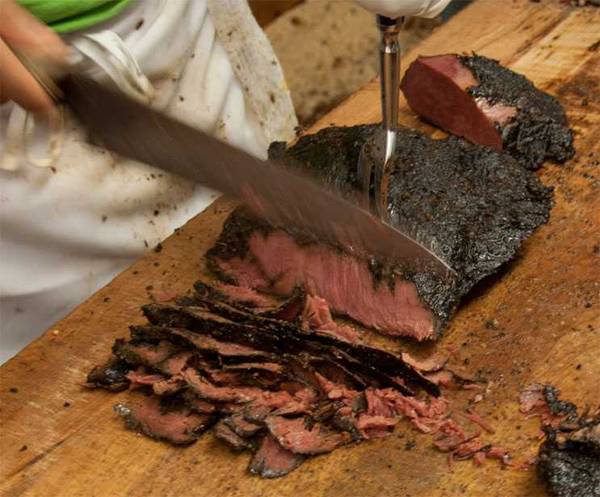
It is absolutely worth waiting in line for the hand carved hot pastrami sandwich at Katz's (doesn't that picture of the carving table, above, just make you verklempt), and if you are lucky, you can rest your tukhus at the table where the most memorable scene from the movie When Harry Met Sally was filmed. Yes, it was in Katz's that Sally (Meg Ryan) demonstrated for nudnik Harry (Billy Crystal) how a woman can fake it. Estelle Reiner, the mamele of director Rob Reiner, after watching Sally moan and groan and pound the table, utters one of the best lines in the history of filmdom: "I'll have what she's having". Kohn says Sally's ecstasy wasn't an act, it was the pastrami, but it looks to me like she is having the turkey. The whole scene is on the video below.
The place looks like your high school cafeteria. When you enter, you will be given a ticket. Don't lose it or you'll have to pay $50 when you check out. Take your place in a fast moving line and schmooze with the other droolers. You can get table service, but then you'll miss the show at the counter.
When you get to the front of the line, know what you want. Naturally I recommend the pastrami, but you can order all manner of traditional kosher-style cured meats like corned beef, a Reuben sandwich, beef tongue, a first rate kosher hot dog, knoblewurst, killer salami, and kishka. There's also chopped liver, liverwurst, and, of course, bagels with a schmear and lox. Save room for the bowl of half-sour pickles and pickled tomatoes on every table, or order matzo ball soup, knishes, latkes, blintzes, or kugel. Finish with a classic New York cheesecake and wash it all down with a beer or an egg cream. They sell no chazeray here.
If you need a Yiddish cheat sheet, scroll down. Learn these terms so you sound like a maven and so you don't have to ask for an explanation like a goy, even if you and all the Irish shamuses and most everyone else in the joint are. When you're done, you can "Send a Salami to a Boy in the Army" something they have been doing since the 1940s.
My standard order is pastrami on rye with yellow mustard on both slices of bread. That's it, bubbie. When the carver asks if you want "fatty or lean", don't be meshuga. Answer "fatty". If you want to sound expert say "plenty of speck (pronounced "shpek"), please". This is no time to count calories. If he said "juicier" or "drier" you wouldn't hesitate, would you? But this is serious fleishig so they calls it the ways they sees it. You got a problem with that?
Place a tip on the counter as he carves, and he'll slip you a nice free nosh. The meat is piled high, and you can get it with mustard, kraut, and melted Swiss. Don't be a putz and ask for mayo. And by the way, when it comes out of the steam box, it looks like a meteorite. It is not burned. That is just the spice rub that has darkened during the smoking process. And when it is carved, it is bright pink. It is not undercooked, that's just the color it turns during the curing process.
How Katz's makes pastrami
As best as I can tell, Katz's process begins with plate, a.k.a. navel. This is a cut from the area below the ribs, behind the brisket and it is a lot fattier than brisket and has a lot of unchewable sinew. Groceries don't normally carry navel so you will have to order it. When you order it you might get a mess of sinew. I recommend you go with brisket. It is more reliable and more expensive. Brisket is the pectoral muscles.
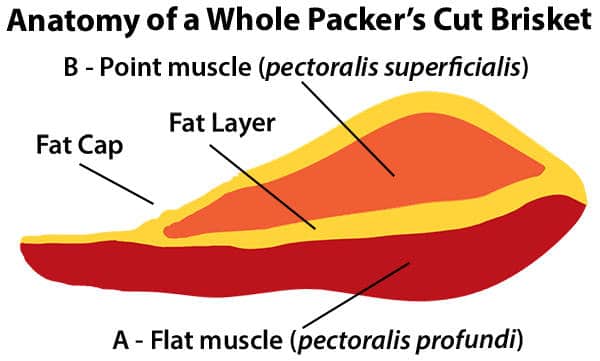
Chef Kohn says they soak the meat for 3 to 4 weeks in a salty, spicy briney wet cure of salt and sodium nitrite, a curing agent. What comes out is essentially corned beef, but their pastrami process is different from their corned beef process because their corned beef is dry cured, not soaked in a brine. At least that's what they tell me.
After wet curing, the pastrami is then coated with a secret rub that tastes to be mostly black pepper and coriander, and then it is refrigerated for a day or two. Then it is smoked, refrigerated for a day or two, and finally, the day it is to be served, it is steamed.
A sneaky shortcut to copy Katz pastrami
To do it all the way from scratch there are several time consuming steps:
- Cure the beef.
- Soak it to desalinate.
- Rub.
- Smoke.
- Texas Crutch.
- Serve.
You can eliminate the step (1) and go straight to step (2) by buying a good corned beef. But beware, not all commercial corned beef is the same. Some are poor quality and some have up to 35% of its weight injected water and salt.

Making your own corned beef and turning it into pastrami means that you can make it to your taste. Like cloves? Gahead. Want sugar in the rub? I won't tell on you. Want more smoke? Who's gonna stop you? More pepper? Bless you. Trust me, boychik, do it yourself and you will eat shards of meat packed with spicy flavor and silky richness mit groys fargenign. Surprisingly, the smoke wraps its fingers into everything without being obvious. Forgive me if I kvell.
No smoke ring in pastrami
Notice that there is no smoke ring in pastrami, the pink ring on and below the surface typical in smoked meats, even barbecue brisket. That's because the smoke ring is nitrite tinged myoglobin in the meat caused by compounds in the smoke. This meat is pink throughout because of the curing salt used in making the corned beef which has sodium nitrite in it. Don't worry, it's safe.
Grocery store pastrami
Most of it is made from lean cuts like round, injected with brine and nitrites, and sliced thin. Not the same by a long shot.
Montreal Smoked Meat
Since the Romanian Jews started in the 1890s they've been making a version of pastrami in Montreal that they call simply smoked meat. It is usually made from brisket. You can order your smoked meat lean, medium, or fatty to get different parts of the brisket on your sandwich. Both pastrami and Montreal smoked meat are typically served on rye bread with mustard, but smoked meat sandwiches tend to be smaller than pastrami sandwiches.
Some other key differences: Montreal smoked meat usually is dry brined with curing salt and often has a darker red color than pastrami, which is typically pinkish red. Montreal smoked meat rarely has sugar in the rub, so the spice taste is more intense. The city of Montreal outlawed wood smoking decades ago, so the meat is most often smoked in an electric smoker. Otherwise, pastrami and Montreal smoked meat are very similar.
Cheat sheet for Katz's menu and translating the Yiddish used in this article
Forgive me for being a bit too cute for my own good, but I could not help, ahem, spicing things up with a little Yiddish with a lot of help from the Yiddish Glossary on Bubbygram. Yiddish is like Spanglish, a mashup of an old world language or two, in this case German, Russian, and Hebrew, with English. Ditto with the menu. The recipes originated in Old Country peasant food, and were adapted in the US. Many of you will recognize some of the words which have crept into daily use by evengoys, but if you need a translation, here you go:
- Bagels.
- Let's get this straight. True bagels do not have raisins, chocolate, jalapeno, or cheese. The are either plain, onion, garlic, sesame, poppy, and everything (all of the above). The rest are what I callbageloids.
- Blintzes.
- A crepe stuffed with a ricotta-like cheese, folded into an eggroll like packed, and pan fried.
- Boychik.
- Little boy. Ususally used to describe a big boy.
- Bubbie.
- Short forbubala, which is what we call grandma. It means something like "sweetie".
- Charoses.
- A chopped apple sauce with raisins and sweet wine served at Passover. It deserves to be served more often.
- Chazeray.
- Junk.
- Chopped Liver.
- Cooked chicken liver chopped and mixed with onions, seasonings, and occasionally brandy. Typically served on rye bread. Like much Jewish food, it is peasant food, hence the expression "What am I, chopped liver?"
- Chutzpah.
- Brazen cheekiness. Ballsiness. Like the boy who killed his parents and then begged the judge for mercy because he was an orphan.
- Egg Cream.
- Chocolate or vanilla syrup mixed with milk and seltzer, no egg.
- Ess, bench, sei a mensch!
- Eat, pray, be a man, don't act like a jerk!
- Fleishig.
- Flesh. Meat.
- Goy.
- Non-Jew.
- Haimisch.
- Simple. Affable.
- Kishka.
- A fat beef sausage. Also means guts. Now we know wher Texas Hot Guts comes from.
- Knishes.
- A baseball sized potato dumpling sort of thingy.
- Knoblewurst.
- A garlicy sausage.
- Kosher.
- Adheres to the dietary rules handed down to Jews and described in the Old Testament.
- Kugel.
- Noodle pudding.
- Kvell.
- Bursting with pride.
- Latkes.
- Potato pancakes.
- Liverwurst.
- A soft spreadable sausage made from pig livers. No, it is not kosher.
- Lox.
- Raw salmon cured with salt. When most people speak of lox they really mean Nova lox, which are lox smoked.
- Macher.
- A big shot, a guy who makes things happen, literally a maker.
- Mamele.
- Mother.
- Matzoh.
- A flat cracker made from unleavened dough, which means dough without yeast.
- Matzo Ball Soup.
- Chicken soup with balls made from ground matzoh floating in them.
- Maven.
- An expert. Often used sarcastically.
- Megillah.
- The whole, unedited, long, boring story.
- Meshuga.
- Crazy. Waaaaay crazy.
- Mit groys fargenign.
- With great pleasure.
- Reuben.
- One of the world's great sandwiches. Corned beef, Swiss, kraut, and Russian dressing on very fresh rye.
- Schlep.
- Drag one's self somewhere.
- Shamus.
- Someone who helps officiate and guard at the synagogue.
- Shmeer.
- A smear of something, especially cream cheese on a bagel.
- Shmooze.
- Network, chat, gossip.
- Shtetl.
- Small European towns with mostly Jewish populations.
- Speck.
- Fat. To be cherished, not avoided.
- Nosh.
- Nibble. Taste.
- Nudnick.
- An annoying person.
- Putz.
- A nickname for a diminutive male organ used to refer to a really distasteful person.
- Tukhus.
- Your butt.
- Verklempt.
- On the verge of tears. Overcome with anger or joy.
Other delicious delis
Want to start a fight? Proclaim that Katz's is the best deli in New York. There will surely be someone within earshot who will argue vigorously in favor of the 2nd Avenue, Stage, Eisenberg, Zabar's, or one of the dozens of others. Ask me and I'll say Katz's. I have not tasted them all. That is a lifetime of work. Sadly, Jewish delis are an endangered species. If this is a topic of interest to you, and it should be, get ahold of David Sax's book Save the Deli: In Search of Perfect Pastrami, Crusty Rye, and the Heart of Jewish Delicatessen.
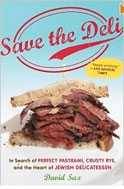
The Priest and the Rabbi confess
Although charoses and latkes are great with pastrami and even pork ribs, pork is forbidden in the homes of observant Jews because it violates their Kosher dietary laws. But that doesn't mean all kosher Jews have never tasted ribs…
So the rabbi gets on the airplane and is pleasantly surprised to find he is seated next to a Catholic priest. He introduces himself, and they begin a conversation. After a while the priest turns to the rabbi, lowers his voice, and says "Tell me rabbi, I don't know much about your religion. Is it true you are not allowed to eat pork?"
The rabbi chuckles and says that, yes, it is true, he is not allowed to eat pork. He explains the laws of kosher.
The priest is both puzzled and amused. He leans toward the rabbi and asks "Have you really gone your whole life without pork? Have you never had bacon or ribs? Have you never tried it once, just out of curiosity?"
The rabbi is silent for a moment and then whispers "Well, yes, I did try ribs once, just out of curiosity."
"Did you like it?"
"Oh, my, yes, I had ribs on a business trip to Memphis at Corky's. They were wonderful! Did you know the founders of Corky's were Jewish? I wish I could eat their pork all the time! Now you tell me Father, is it true that you are not allowed to have sex?"
"Yes, it is true. I am married to the church."
"Tell me honestly Father. Have you never tried it, just once, just out of curiosity?"
The priest is silent for a moment, and realizing that his god already knew the truth, he whispered to his new friend "I must confess, I have had sex, but only once, with a nun."
There was an awkward silence for a few moments, and finally the rabbi looks the priest in the eyes and quietly asks "Did you like it?"
"Not as much as ribs" was the reply.
Get a sneak peak at Meathead's next book. He shares chapters with members of our Pitmaster Club as he finishes them. Click here for a free 30 day trial. No credit card needed. No spam. Click here to Be Amazing!
Simple And Smoky Homemade Pastrami Recipe
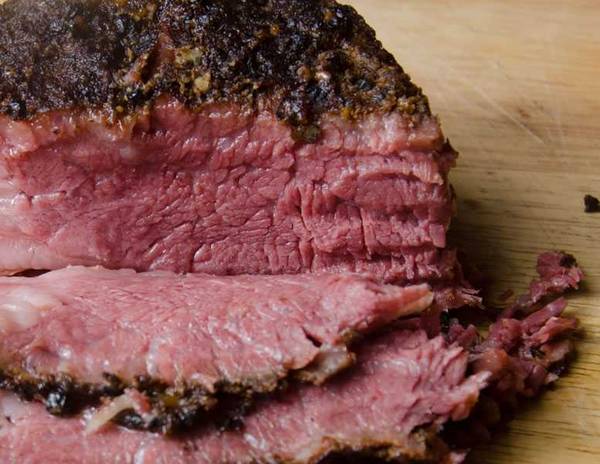
Tell others what you thought of it and give it a star rating below.
This homemade pastrami recipe is complex and smoky, but not in the way that other smoked meats are smoky. The smoke in this beef pastrami is not overt. It is blended in thoroughly. Much like Katz's pastrami, this is highly seasoned, but the black pepper and coriander rub is never domineering, and swimming across all your buds are a range of other herbs and spices. Once you try this recipe you may need to open your own deli!
NOTE: In early 2022, I modified the recipe to eliminate the steaming step because the Texas Crutch, wrapping tightly in foil during the cooking step, works just as ell with less fuss, mess, and it retains more of the rub and bark.
Serve with: an egg cream or a local New York beer like a Brooklyn Lager.
Makes:
About 3 pounds
Servings:
Takes:
- 4 pounds corned beef, preferably our homemade recipe
- 3 tablespoons pastrami rub
About store bought corned beef. Corned beef comes in two forms, ready to eat, and brined. Ready to eat corned beef is cured, then cooked, and usually packaged in slices or sliced at the deli counter. Do not use this! Brined corned beef is usually a hunk of brisket that has been cured in a salt solution and packaged in a hearty cryovac plastic bag with some of the brine. It has not been cooked yet. That's the stuff you want.
These recipes were created in US Customary measurements and the conversion to metric is being done by calculations. They should be accurate, but it is possible there could be an error. If you find one, please let us know in the comments at the bottom of the page
-
Prep the corned beef. Buy or make corned beef. For pastrami, the flat section of the brisket is favored by many because it makes nice even slices for sandwiches, but I prefer the point section of the brisket because it is fattier, richer, and more tender. It can also be made from flank steak, or leaner cuts, or even from boneless short plate (rib meat). Remove all of the fat cap and if there is any filmy membrane on the other side, remove it all.
-
Desalinate. Put the corned beef in a pot slightly larger than the meat and cover it with cold water in the fridge for at least 8 hours. Change the water at least once. This removes excess salt. Trust me, you need to do this or you will be gulping water all night after your meal.
-
Rub. Make the rub. Rinse the meat, and while it is damp, apply the rub liberally and press it into the surface to help it adhere.
-
Fire up. Set up your grill in 2 zones for smoking or set up your smoker. Preheat to 225°F. Pick your wood. I don't think it makes a huge difference with all the other flavors banging around in there. My best batch was with cherry wood.
-
Cook. Place the meat on the smoker or on the indirect heat side of the grill. You only need to smoke it with indirect heat until it reaches the stall at about 160°F and the crust is brown. Then wrap it tightly in foil and roast it up to 203°F. This is called the Texas Crutch and it does wonders. It significantly reduces cooking time and makes the end product much more tender and juicy.
-
Slicing. Slicing is crucial to maximize tenderness. Look at the meat and notice which way the grain is running. Cut it by hand in thin slices, about 1/8" thick, perpendicular to the grain. If you cut parallel to the grain it will be much chewier. Don't try to slice it with a machine. It will just fall apart.
-
Serve. I serve the homemade smoked pastrami on fresh untoasted rye bread. A good brown mustard on both slices is all it needs. If you want, you can make a Rockin' Pastrami Reuben with sauerkraut, melted swiss, and thousand island or Russian dressing, or beter still, my famous Burger Glop. Reubens were originally made with corned beef, but there's no rule that you can't make one from pastrami. In fact, I prefer it.
Leftovers freeze well and they can be reheated in the microwave or steamed. They can also be made into a killer hash. Ess, bench, sei a mensch!
Calories: 292 kcal | Carbohydrates: 9 g | Protein: 53 g | Fat: 15 g | Saturated Fat: 9 g | Cholesterol: 121 mg | Sodium: 1462 mg | Potassium: 32 mg | Fiber: 5 g | Sugar: 5 g | Vitamin A: 23 IU | Vitamin C: 5 mg | Calcium: 94 mg | Iron: 9 mg
daigletheryiewer92.blogspot.com
Source: https://amazingribs.com/tested-recipes/beef-and-bison-recipes/home-made-pastrami-thats-close-katzs-recipe/

0 Response to "Pastrami From a Corned Beef Recipe"
Postar um comentário